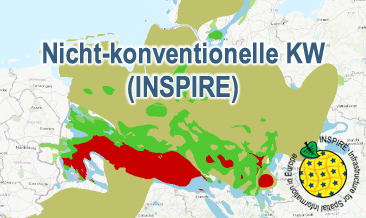The WMS Nicht-konventionelle KW (INSPIRE) presents the results of the NiKo project according to data specifications Energy Resources (D2.8.III.20) und Geology (D2.8.II.4_v3.0). NiKo stands for „unconventional hydrocarbons“, „Nicht-konventionelle Kohlenwasserstoffe“ in German. In the NiKo project the Federal Institute for Geosciences and Natural Resources (BGR) has investigated the potential resources for shale oil and shale gas in Germany. The study was published in 2016 as a report titled „Schieferöl und Schiefergas in Deutschland – Ressourcen und Umweltaspekte“ (available in German only). The colloquial terms shale oil and shale gas refer to oil and natural gas resources in sedimentary shale rock formations, with high organic matter content. In the study, seven formations were identified to have a shale oil and/or gas potential in Germany and their distribution has been mapped in small scale. For each of the formations the organic-rich facies distribution is provided as layer and, if appropriate, the regional potential resource distribution: Fischschiefer (Oligocene), Blättertone (Barremium - Lower-Aptian), Wealden (Berriasium), Posidonienschiefer (Lower-Toarcium), Middel-Rhaetium (Oberkeuper), Permokarbon (Stefanium - Rotliegend) und Lower Carboniferous (Upper Alaunschiefer (Kulm-Facies) + Kohlenkalk-Facies). According to the overview maps in the report the following layers are provided, omitting however the sub-category “possible potential regions”. Bituminous facies distribution (0-5000 m depth) – data specification Geology: GE.GeologicUnit.Fischschiefer_distribution, GE.GeologicUnit.Blaettertone_distribution, GE.GeologicUnit.Wealden_distribution, GE.GeologicUnit.Posidonienschiefer_distribution, GE.GeologicUnit.Mittelrhaetium_black_shale_thicker_20m_distribution, GE.GeologicUnit.Permokarbon_black_shale_distribution, GE.GeologicUnit.Unterkarbon_Hangende_Alaunschiefer_distribution und GE.GeologicUnit.Unterkarbon_Kohlenkalk Facies layers are coloured according to the corresponding oldest formation age (olderNamedAge). Distribution shale oil and shale gas – potential resources (1000 - 5000 m depth) – data specification Energy Resources: ER.FossilFuelRessource.Blaettertone, ER.FossilFuelRessource.Wealden, ER.FossilFuelRessource.Posidonienschiefer, ER.FossilFuelRessource.Mittelrhaetschiefer, ER.FossilFuelRessource.Permokarbon und ER.FossilFuelRessource.Unterkarbon The shale oil and shale gas distribution layers are not coloured according to INSPIRE guidelines, but rather as common international practice in green and red, respectively. The distribution maps of the potential resources for shale oil and gas are based on geoscientific criteria. Further non-geoscientific limiting criteria, e.g. exclusion areas, have not been taken into account for the assessment. These assessments are based on appraisements of input parameters naturally with large uncertainties for the potential resources and their distribution in the deep underground. Based on the incipient exploration status of unconventionals in Germany, these resources are considered as undiscovered. The assessed shale oil and gas resources for Germany, represent the order of magnitude of potential resources. Source: BGR 2016 - Schieferöl und Schieferöl in Deutschland in 2016: - Potenziale und Umweltaspekte https://www.bgr.bund.de/DE/Themen/Energie/Downloads/Abschlussbericht_13MB_Schieferoelgaspotenzial_Deutschland_2016.html Der WMS Nicht-konventionelle KW (INSPIRE) stellt die Ergebnisse des Projektes NiKo (= Nicht-konventionelle Kohlenwasserstoffe) entsprechend der Datenspezifikationen Energy Resources (D2.8.III.20) und Geology (D2.8.II.4_v3.0) INSPIRE-konform dar. Die Bundesanstalt für Geowissenschaften und Rohstoffe (BGR) hat das Potenzial an Schieferöl und Schiefergas in Deutschland im Projekt NiKo untersucht und 2016 in der Studie „Schieferöl und Schiefergas in Deutschland – Ressourcen und Umweltaspekte“ veröffentlicht. Die umgangssprachlichen Begriffe Schieferöl und Schiefergas bezeichnen Erdöl- und Erdgasvorkommen in organisch-reichen (bituminösen) sedimentären Tongesteinen. In der Studie werden insgesamt sieben Formationen mit Schieferöl- und/oder Schiefergaspotenzial identifiziert und die Verbreitung der Potenzialgebiete kleinmaßstäblich erfasst. Für diese Formationen werden jeweils die Verbreitung der bitumösen Fazies und sofern zutreffend die Potenzialgebiete mit Schiefergas bzw. Schieferöl dargestellt: Fischschiefer (Oligozän), Blättertone (Barremium bis Unter-Aptium), Wealden (Berriasium), Posidonienschiefer (Unter-Toarcium), Mittel-Rhaetium (Oberkeuper), Permokarbon (Stefanium bis Rotliegend) und Unterkarbon (Hangender Alaunschiefer (Kulm-Fazies) + Kohlenkalk-Fazies). Entsprechend den Übersichtskarten in der Studie werden für diese Formationen die folgenden Layer zur Verfügung gestellt (Im Vergleich zu den Original-Daten werden die möglichen Potenzialgebiete mit Schiefergas bzw. Schieferöl nicht dargestellt.): Verbreitung der bituminösen Fazies (0-5000 m Tiefe) – Datenspezifikation Geology: GE.GeologicUnit.Fischschiefer_distribution, GE.GeologicUnit.Blaettertone_distribution, GE.GeologicUnit.Wealden_distribution, GE.GeologicUnit.Posidonienschiefer_distribution, GE.GeologicUnit.Mittelrhaetium_black_shale_thicker_20m_distribution, GE.GeologicUnit.Permokarbon_black_shale_distribution, GE.GeologicUnit.Unterkarbon_Hangende_Alaunschiefer_distribution und GE.GeologicUnit.Unterkarbon_Kohlenkalk Die einzelnen Fazies-Layer werden entsprechend der Farbe des Anfangalters (olderNamedAge) grafisch dargestellt. Verbreitung Schieferöl –und/oder Schiefergas - Potenzialgebiet (1000 - 5000 m Tiefe) – Datenspezifikation Energy Resources: ER.FossilFuelRessource.Blaettertone ER.FossilFuelRessource.Wealden, ER.FossilFuelRessource.Posidonienschiefer, ER.FossilFuelRessource.Mittelrhaetschiefer, ER.FossilFuelRessource.Permokarbon und ER.FossilFuelRessource.Unterkarbon Die Schieferöl- und Schiefergas-Potenzialgebiete werden nicht nach den INSPIRE-Richtlinien grafisch dargestellt, sondern – wie international üblich – grün bzw. rot dargestellt. Die Verbreitungskarten der Potenzialgebiete beruhen auf geowissenschaftlichen Kriterien. Bei den Abschätzungen nicht berücksichtigt sind weitere, nicht-geowissenschaftliche Kriterien, wie z.B. Ausschlussgebiete. Zugrunde liegen Abschätzungen, die naturgemäß mit Unsicherheiten über die möglichen Vorkommen und deren Verbreitung behaftet sind. Auf Grund des Erkundungsgrades der Vorkommen, sind die Ressourcen als nicht nachgewiesen (undiscovered) einzustufen. Die ermittelten Schieferöl- und Schiefergasressourcen in Deutschland geben die Größenordnung der Potenziale an. Referenz: BGR 2016 - Schieferöl und Schieferöl in Deutschland- Potenziale und Umweltaspekte https://www.bgr.bund.de/DE/Themen/Energie/Downloads/Abschlussbericht_13MB_Schieferoelgaspotenzial_Deutschland_2016.html





